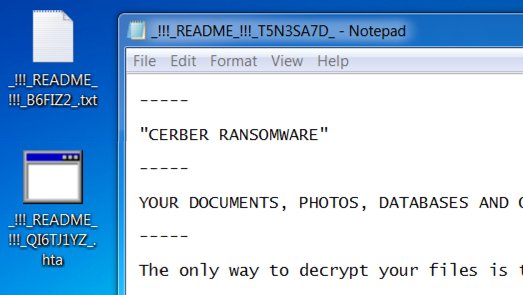Cerber extortion plague keeps evolving. Despite the infection is very old in terms of the cyber world standards, its new versions ensure the threat poses critical challenges to IT security. There are two essential updates in the new version under review. First, the ransomware assigns a distinct name for its communication file. The item is available in two formats, hence two names as follows:
_!!!_README_!!!_%random%_.txt
_!!!_README_!!!_%random%_.hta

This update rather aims at aggravating the ransomware identification. The other modification is more essential. It features a new propagation vector. Now, the infection hits computer system via Windows vulnerability identified as CVE-2017-0199. This attack leverages the flaw inherent in MS Office software. The attackers first create a crafted file. This file is meant to be opened by the victim. The opening triggers a hidden routine that connects the host PC to remote server ensuring the ransomware download and installation.
Otherwise, the Cerber (_!!!_README_!!!_%random%_) edition under review is basically true to its type. Most of its infiltrations occur as users receive and open a spam mail. The spam is more sophisticated than a basic mass-mailing. It may indicate user’s personal details and originate from a familiar sender. That is to say, the crooks make use of a compromised account. They examine the communication and retrieve relevant details. Therefore, the infecting mail may look like a routine or casual communication from your personal/business contact. That explains why the users often rush headlong into opening the infecting MS Office document.
Again, the opening launches the installation algorithm. Cerber installation attempts to resemble a Windows component installation. For the installation to complete, the system needs to reboot. The installation routine thus may induce critical system error as a final step. That, obviously, forces the user to reboot the operating system.
The encryption does not follow the installation immediately. Prior to ensuring its data locking payload, the ransomware scans computer system in order to discard certain file formats. Such selectiveness ensures critical system files remain readable. The system keeps functioning. The users can read the Cerber ransom note as contained in the following files:
_!!!_README_!!!_%random%_.txt
_!!!_README_!!!_%random%_.hta
The message prompts the reader to pay the ransom for releasing the locked data. The unlocking is available with the private key that can decrypt the data scrambled with military-grade AES and/or RSA cipher.
The victims witness any payments do not guarantee a proper key is properly released. Moreover, the amount claimed is rather essential. It typically exceeds 1 BTC, now traded for more than USD 1000.
There is no 100% ransom-free recovery. Nevertheless, the workflows below satisfy the data-unlocking demands for most of the Cerber encryption cases.
Automatic removal of Cerber ransomware
The benefits of using the automatic security suite to get rid of this infection are obvious: it scans the entire system and detects all potential fragments of the virus, so you are a few mouse clicks away from a complete fix.
- Download and install recommended malware security suite
- Select Start Computer Scan feature and wait until the utility comes up with the scan report. Proceed by clicking on the Fix Threats button, which will trigger a thorough removal process to address all the malware issues compromising your computer and your privacy.
Restore files locked by Cerber
Cerber represents a unique category of malicious software whose attack surface reaches beyond the operating system and its components, which is why removing the virus itself is a part of the fix only. As it has been mentioned, it encrypts one’s personal information, so the next phase of the overall remediation presupposes reinstating the files that will otherwise remain inaccessible.
-
Launch data recovery software
Similarly to the rest of its fellow-infections, Cerber most likely follows an operational algorithm where it erases the original versions of the victim’s files and actually encrypts their copies. This peculiarity might make your day, because forensics-focused applications like Data Recovery Pro are capable of restoring the information that has been removed. As the virus further evolves, its modus operandi may be altered – in the meanwhile, go ahead and try this.
-
Take advantage of Volume Shadow Copy Service
This technique is based on using the native backup functionality that’s shipped with Windows operating system. Also referred to as Volume Snapshot Service (VSS), this feature makes regular backups of the user’s files and keeps their most recent versions as long as System Restore is on. Cerber virus hasn’t been found to affect these copies therefore the restoration vector in question is strongly recommended. The two sub-sections below highlight the automatic and manual workflow.
- a) Use Shadow Explorer
Shadow Explorer is an applet that provides an easy way of retrieving previous versions of files and folders. Its pro’s include an intuitive interface where the computer’s entire file hierarchy is displayed within one window. Just pick the hard disk volume, select the object or directory to be restored, right-click on it and choose Export. Follow the app’s prompts to get the job done.

- b) Use file properties
Essentially, what the above-mentioned Shadow Explorer tool does is it automates the process that can otherwise be performed manually via the Properties dialog for individual files. This particular approach is more cumbrous but just as effective as its software-based counterpart, so you can proceed by right-clicking on a specific file, which has been encrypted by Cerber ransomware, and selecting Properties in the context menu. The tab named Previous Versions is the next thing to click – it displays available versions of the file by date of the snapshot creation. Pick the latest copy and complete the retrieval by following the prompts.

-
Data backups work wonders
Ransomware like Cerber isn’t nearly as almighty and destructive in case you run regular file backups to the cloud or external data media. The virus itself can be completely removed in a matter of minutes, and the distorted information can then be just as easily recovered from the backup. Luckily, this is a growing trend, so ransom Trojans are hopefully going to become less subversive in the near future.
Verify thoroughness of the removal
Having carried out the instructions above, add a finishing touch to the security procedure by running an additional computer scan to check for residual malware activity
